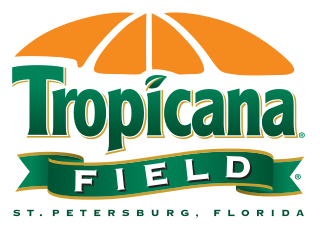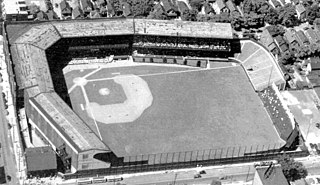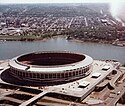
Fenway Park is a baseball stadium located in Boston, Massachusetts, United States, near Kenmore Square. Since 1912, it has been the home of the Boston Red Sox, the city's American League baseball team, and since 1953, its only Major League Baseball (MLB) franchise. While the stadium was built in 1912, it was substantially rebuilt in 1934, and underwent major renovations and modifications in the 21st century. It is the oldest active ballpark in MLB. Because of its age and constrained location in Boston's dense Fenway–Kenmore neighborhood, the park has many quirky features, including "The Triangle", Pesky's Pole, and the Green Monster in left field. It is the fifth-smallest among MLB ballparks by seating capacity, second-smallest by total capacity, and one of eight that cannot accommodate at least 40,000 spectators.

In baseball, a home run is scored when the ball is hit in such a way that the batter is able to circle the bases and reach home plate safely in one play without any errors being committed by the defensive team. A home run is usually achieved by hitting the ball over the outfield fence between the foul poles without the ball touching the field. Far less common is the "inside-the-park" home run where the batter reaches home safely while the baseball is in play on the field.

The Green Monster is a popular nickname for the 37-foot-2-inch-high (11.33 m) left field wall at Fenway Park, home to the Boston Red Sox of Major League Baseball. The wall is 310 feet (94 m) from home plate and is a popular target for right-handed hitters.

Oracle Park is a Major League Baseball stadium in the SoMa neighborhood of San Francisco, California. Since 2000, it has been the home of the San Francisco Giants. Previously named Pacific Bell Park, SBC Park, and AT&T Park, the stadium's current name was purchased by the Oracle Corporation in 2019.

Tropicana Field is a multi-purpose domed stadium located in St. Petersburg, Florida, United States. The stadium has been the home of the Tampa Bay Rays of Major League Baseball (MLB) since the team's inaugural season in 1998. The stadium is also used for college football, and from December 2008 to December 2017 was the home of the St. Petersburg Bowl, an annual postseason bowl game. The venue is currently the only non-retractable domed stadium in Major League Baseball, making it the only year-round indoor venue in MLB. Tropicana Field is the smallest MLB stadium by seating capacity when obstructed-view rows in the uppermost sections are covered with tarps as they are for most Rays games.

The Polo Grounds was the name of three stadiums in Upper Manhattan, New York City, used mainly for professional baseball and American football from 1880 through 1963. The original Polo Grounds, opened in 1876 and demolished in 1889, was built for the sport of polo. Bound on the south and north by 110th and 112th streets and on the east and west by Fifth and Sixth (Lenox) avenues, just north of Central Park, it was converted to a baseball stadium when leased by the New York Metropolitans in 1880.

Shibe Park, known later as Connie Mack Stadium, was a ballpark located in Philadelphia. It was the home of the Philadelphia Athletics of the American League (AL) and the Philadelphia Phillies of the National League (NL). When it opened April 12, 1909, it became baseball's first steel-and-concrete stadium. In different eras it was home to "The $100,000 Infield", "The Whiz Kids", and "The 1964 Phold". The venue's two home teams won both the first and last games at the stadium: the Athletics beat the Boston Red Sox 8–1 on opening day 1909, while the Phillies beat the Montreal Expos 2–1 on October 1, 1970, in the park's final contest.

League Park was a baseball park located in Cleveland, Ohio, United States. It was situated at the northeast corner of Dunham Street and Lexington Avenue in the Hough neighborhood. It was built in 1891 as a wood structure and rebuilt using concrete and steel in 1910. The park was home to a number of professional sports teams, most notably the Cleveland Indians of Major League Baseball. League Park was first home to the Cleveland Spiders of the National League from 1891 to 1899 and of the Cleveland Lake Shores of the Western League, the minor league predecessor to the Indians, in 1900. From 1914 to 1915, League Park also hosted the Cleveland Spiders of the minor league American Association. In the late 1940s, the park was also the home field of the Cleveland Buckeyes of the Negro American League.

Griffith Stadium stood in Washington, D.C., from 1911 to 1965, between Georgia Avenue and 5th Street, and between W Street and Florida Avenue NW.

National League Park, commonly referred to as the Baker Bowl after 1923, was a baseball stadium and home to the Philadelphia Phillies from 1887 until 1938, and first home field of the Philadelphia Eagles from 1933 to 1935. It opened in 1887 with a capacity of 12,500, burned down in 1894, and was rebuilt in 1895 as the first ballpark constructed primarily of steel and brick, and first with a cantilevered upper deck. The ballpark's first base line ran parallel to Huntingdon Street; right field to center field parallel to N Broad Street; center field to left field parallel to Lehigh Avenue; and the third base line parallel to 15th Street. The stadium was demolished in 1950.

Braves Field was a baseball park located in Boston, Massachusetts. Today the site is home to Nickerson Field on the campus of Boston University. The stadium was home of the Boston Braves of the National League from 1915 to 1952, prior to the Braves' move to Milwaukee in 1953. The stadium hosted the 1936 Major League Baseball All-Star Game and Braves home games during the 1948 World Series. The Boston Red Sox used Braves Field for their home games in the 1915 and 1916 World Series since the stadium had a larger seating capacity than Fenway Park. Braves Field was the site of Babe Ruth's final season, playing for the Braves in 1935. From 1929 to 1932, the Boston Red Sox played select regular season games periodically at Braves Field. On May 1, 1920, Braves Field hosted the longest major league baseball game in history – 26 innings, which eventually ended in a 1–1 tie.

Crosley Field was a Major League Baseball park in Cincinnati, Ohio. It was the home field of the National League's Cincinnati Reds from 1912 through June 24, 1970, and the original Cincinnati Bengals football team, members of the second (1937) and third American Football League (1940–41). It was not the original home of the current NFL franchise of the same name: the home of those Bengals in 1968 and 1969 was nearby Nippert Stadium, located on the campus of the University of Cincinnati. Crosley Field was on an asymmetrical block bounded by Findlay Street (south), Western Avenue, Dalton Avenue (east), York Street (north) and McLean Avenue (west) in the Queensgate section of the city. Crosley has the distinction of being the first major-league park with lights for playing night games.

Kansas City Municipal Stadium was an American baseball and football stadium in the central United States, located in Kansas City, Missouri. It was located at the corner of Brooklyn Avenue and E. 22nd Street.

A baseball field, also called a ball field or baseball diamond, is the field upon which the game of baseball is played. The term can also be used as a metonym for a baseball park. The term sandlot is sometimes used, although this usually refers to less organized venues for activities like sandlot ball.

Parkway Field is the name of a minor league baseball and college baseball park that stood in Louisville, Kentucky. It was home to the Louisville Colonels of the American Association from 1923 into the mid-1950s, the Louisville Buckeyes of the Negro American League in 1949, and then of the University of Louisville team for several decades until they abandoned it in 1998 and moved to Cardinal Stadium. Prior to its demolition, Parkway Field had become a home run haven for U of L Head Coach Gene Baker's "Over the Wall Gang." The Cards led NCAA Division I in long balls in 1991 and 1992 while finishing runnerup in 1995. The 1991 squad featured six Cardinals who tallied at least 15 roundtrippers each, Richie Hawks, Rob Newman, Greg Gooding, Dan Kopriva, Charlie Allen, and Darren Oppel. The 1992 club also topped the nation in team batting average and team slugging percentage.

A ballpark, or baseball park, is a type of sports venue where baseball is played. The playing field is divided into the infield, an area whose dimensions are rigidly defined, and the outfield, where dimensions can vary widely from place to place. A larger ballpark may also be called a baseball stadium as it shares characteristics with other outdoor stadiums.

Tingley Field was a baseball stadium in Albuquerque, New Mexico, which served as the home of professional baseball in Albuquerque from 1932 to 1968. It could accommodate 5000 fans, with seating for 3000.
Newark Schools Stadium is the name of two stadiums that were both located on Bloomfield Avenue between Abingdon and Roseville Avenues in the Roseville section of Newark, New Jersey.

Hamtramck Stadium, also known as Roesink Stadium is one of only 12 remaining Negro league baseball stadiums. It is located at 3201 Dan Street, in Veterans Park, in Hamtramck, Michigan. The stadium was listed on the National Register of Historic Places in 2012. The stadium is located near, and occasionally confused with, Keyworth Stadium. The stadium was rededicated on June 20, 2022, as part of the Juneteenth celebration. In 2020, the stadium's field was renamed Norman "Turkey" Stearnes Field, after Detroit Stars player Turkey Stearnes.

A Chinese home run, also a Chinese homer, Harlem home run, Polo home run, or Pekinese poke, is a derogatory and archaic baseball term for a hit that just barely clears the outfield fence at its closest distance to home plate. It is essentially the shortest home run possible in the ballpark in question, particularly if the park has an atypically short fence to begin with. The term was most commonly used in reference to home runs hit along the right field foul line at the Polo Grounds, home of the New York Giants, where that distance was short even by contemporary standards. When the Giants moved to San Francisco in 1958, the Los Angeles Coliseum, temporary home of the newly relocated Los Angeles Dodgers, gained the same reputation for four seasons until the team took up residence in its permanent home at Dodger Stadium in 1962. Following two seasons of use by the expansion New York Mets in the early 1960s, the Polo Grounds were demolished, and the term gradually dropped out of use.




















